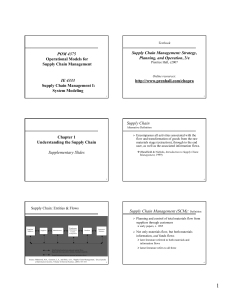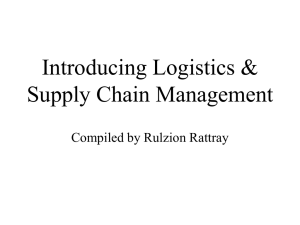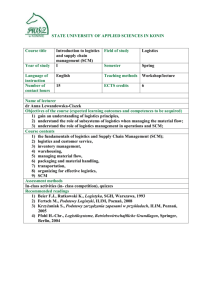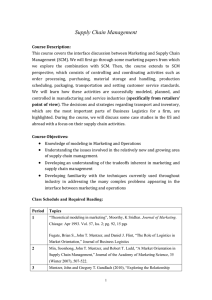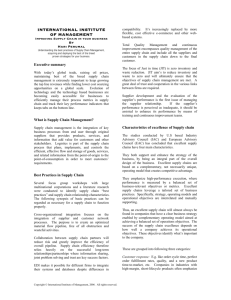A Global View of Supply Chain Management Interview by Darilyn Kane
advertisement
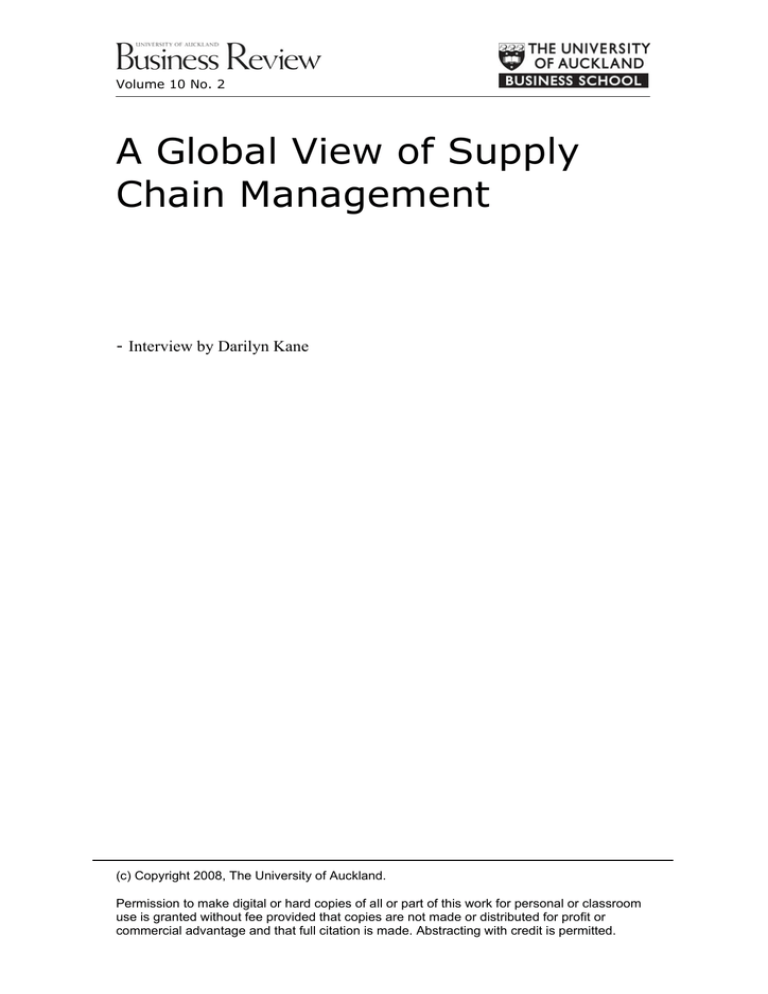
Volume 10 No. 2 A Global View of Supply Chain Management - Interview by Darilyn Kane (c) Copyright 2008, The University of Auckland. Permission to make digital or hard copies of all or part of this work for personal or classroom use is granted without fee provided that copies are not made or distributed for profit or commercial advantage and that full citation is made. Abstracting with credit is permitted. research 30 debrief Interview by Darilyn Kane A Global View of Supply Chain Management Douglas Lambert, Director of the Global Supply Chain Forum, believes that successful Supply Chain Management is about taking a holistic view of the firm and looking beyond the usual boundaries to build relationships with customers and suppliers. UABR: “Supply Chain” is a familiar phrase in business these days and you have been involved in research in the area for more than fifteen years. How would you describe Supply Chain Management? DL: For us, Supply Chain Management (SCM) is an integrated business model that takes a process-based view of how all of the business functions need to work together and how a business relates to its suppliers and customers. The framework we have developed focuses on finding the right level of partnership with customers and suppliers and creating crossfunctional teams that make decisions based on a holistic view of the business. However, there is quite a lot of confusion around the term “supply chain”. Many organisations use the term in job titles and organisation charts but they are taking a much narrower view. It can be interpreted as narrowly as materials flow which is really better described as logistics. I think probably the broadest view of supply chain management other than our framework is some kind of combination of purchasing, operations and logistics. There may be some economies in getting these areas to work together, and talk about the importance of “breaking down silos” has become common. But in fact what is happening is that they are just creating bigger silos. We need a way of thinking horizontally across all of the functions. From our perspective SCM requires the involvement of all of the business functions. We still need the expertise that has been built up within the silos or functions. Dr. Douglas M. Lambert (pictured) is the Director of the Global Supply Chain Forum (GSCF) which researches opportunities for operational excellence in partnership with leading global organisations. He recently visited the Centre for Supply Chain Management at the University of Auckland Business School to co-teach a week-long course based on the GSCF Supply Chain Management Framework. The GSCF is based at Ohio State University where Doug is also the Raymond E. Mason Chair in Transportation and Logistics. University of Auckland Business Review | Spring 2008 31 debrief If we’re going to own factories we need people who know how to operate them, or if we’re buying from logistics service providers we still need some expertise within the business. It is important not to outsource the thinking even if you outsource some of the lifting. Certainly there can be economies by having purchasing, operations and logistics working more closely together. But by not including marketing, sales, finance and R and D we are simply building a bigger silo. To make the best decisions for the business, all functions must be involved. In my view, individuals from those functions that are not involved will maliciously or inadvertently subvert the effort. They will subvert the effort to show that they should have been involved or because they don’t know what the effort is. Here’s a great example from an organisation we have worked with, a manufacturer of consumer durables. They implemented a rapid delivery system that provided retailers with 24 to 48 hour deliveries. This was designed to keep them lean on inventory, so there would be fewer mark-downs and fresher product. If it’s managed right, everything the dealer orders today has already been sold. After six years they had not realised the expected reductions in retailer inventory. The idea was never sold to the sales and marketing people so they were still offering deals on truckloads of appliances directly out of the factory, incentivising customers to buy large volumes. To take a truly holistic view of a business, you also need to include customers and suppliers. In fact, the supply chain starts with your customer network and flows back through to your supplier network, and all the functions of the business need to be involved in managing the combined network. UABR: Your research has involved several well-known global organisations – how has this come about? DL: We started in 1992 and have built up a research centre called the Global Supply Chain Forum. Our research teams work with executives from 15 non-competing companies such as 3M, the Coca-Cola Company, Cargill, Defence Logistics Agency, HP, Halliburton and Shell. The first research project that we worked on was partnership. It didn’t fit anything I’d previously done in my career but the rules of the game were that the members determined the research agenda. So I got very interested in partnerships, because that’s what they were interested in researching. I didn’t realise when we started that this research was going to be a key part of the SCM puzzle, but as our view of SCM developed we realised it is all about relationship management. No company in the group has implemented the entire framework – it’s the combined wisdom of all of the executives and researchers, and that was the goal. Figure 1 Supply Chain Management INFORMATION FLOW Tier 2 Supplier PRODUCT FLOW Tier 1 Supplier Manufacturer PRODUCT FLOW Sales R&D Supply Chain Management Processes Production Finance PRODUCT FLOW Customer PRODUCT FLOW Consumer/ End-User Logistics Purchasing CUSTOMER RELATIONSHIP MANAGEMENT SUPPLIER RELATIONSHIP MANAGEMENT CUSTOMER SERVICE MANAGEMENT DEMAND MANAGEMENT ORDER FULFILLMENT MANUFACTURING FLOW MANAGEMENT PRODUCT DEVELOPMENT AND COMMERCIALIZATION RETURNS MANAGEMENT Note: Process sponsorship and ownership must be established to drive the attainment of the supply chain vision and eliminate the functional barriers that artificially separate the process flows. Source: Douglas M. Lambert, Editor, Supply Chain Management: Processes, Partnerships, Performance, Third Edition, Sarasota, FL: Supply Chain Management Institute, 2008, p. 8. 32 debrief As academics this is a great position to be in – we are not just reporting the news, we are making it. Right now we are working with the companies to implement the framework. For example at Imation, a 3M spin-off, there are process executive sponsors and owners in place and they are implementing the processes all over the world. proposition for every customer, but each one has to meet profit goals. So this is way beyond trucks and trains. UABR: How important is it to get to really know your suppliers and customers? DL: Very important – developing the right type of relationships The results of this research have been published in articles and a is critical. If Colgate manages relationships better than Proctor book which we are updating regularly to reflect our experience with or Unilever then they’re going to win more often. They buy from implementation. In the third edition, published in 2008, there are the same suppliers and sell to the same retailers, so it’s not supply four new chapters. We have totally rewritten the customer service chain against supply chain or the A Team playing the B Team. If I management and supplier relationship management chapters, help my suppliers and customers to do better, those relationships bringing in examples based on how Gillette and other companies are going to grow in a way that they won’t for my competitors. proactively manage customer service and how Coke segmented This also ties in with a new stream of thinking that is emerging suppliers. We are getting a lot of interest in marketing – co-creation of value. Most from outside of the North America now. We of the research on this has been done with decided to team up with excellent universities Developing the right type consumers. Sometimes this may be hard to outside of the USA so we have been to San of relationships is critical. conceptualize. To my way of thinking it is Andrés in Buenos Aires, Cranfield in the If Colgate manages like this: if I buy Colgate toothpaste to get UK and this is the second session that I relationships better than real value I have to brush often enough and have taught with Alan Stenger here at The in the right way, and that’s how I co-create Proctor or Unilever then University of Auckland Business School. The value. But, I have no trouble at all seeing work that he has been doing with the Centre they’re going to win that this is key in a business to business for Supply Chain Management within the more often. relationship. Coke and Cargill work closely University is a great example of starting to together to co-create value – for example develop partnerships. they are jointly developing a new zero calorie natural sweetener, making process improvements to get UABR: This approach seems like a major shift for many inventory out of the supply chain and evaluating transportation organisations, even those who have adopted the narrower forms to reduce the carbon footprint. Deep knowledge of the customer of supply chain you mentioned earlier. What does a business enables you to co-create value and the more cross-functional the model based on Supply Chain Management look like? involvement, the more opportunities that will be identified for value co-creation. DL: It can be a major change, particularly the move to a more holistic view and finding a way to make decisions that are UABR: You mentioned different value propositions for optimal for the whole of the business. Our model identifies eight different customers. What determines what the relationships key business processes. These are cross-functional and cross-firm with each customer or supplier should be? and every function needs to be involved in implementing them (see Figure 1). If you’re a manufacturer like Fisher and Paykel DL: There needs to be a link to corporate and marketing strategy. you are in the middle of the chain, and it looks more like an Thinking about which customers are key to success now and in uprooted tree. The supplier network represents the roots and the future tells us what business we are in, what technologies the customer network the branches. Some roots are going to be we have to be good at and what the key inputs are. We might thicker than others and more important to the success of the decide a specific segment is important, but all customers in tree or the business, just as some suppliers are more important that segment won’t be the same. So we use two or three levels to the success of the business. For example, the company that of segmentation to determine the importance of the customer provides Wendy’s with chicken and beef is going to be more or supplier and that helps us determine the type of relationship important than the one that sells them straws and napkins. And we want to establish. Suppliers can be scored on multiple some customers are going to be worth a lot more than others. For attributes. For example Wendy’s have developed a matrix based a long time Coke was proud of treating all of its customers the on complexity and volume, the result has strategic commodities same way, but then they realised that doesn’t make sense. When in the top right hand corner – beef, chicken, promotional sauces they have customers like Wal-Mart and McDonalds they can’t - and things like straws in the bottom left hand corner. Coke also afford to treat all customers like these customers. And if they uses a matrix but with a whole list of criteria on each axis. They treated Wal-Mart and McDonalds like they would have to in have developed detailed descriptions of how each area should be order to treat all customers the same, they wouldn’t keep them managed – who will be invited to participate in a one and oneas customers. That doesn’t mean they don’t come up with a value half day session using our partnership model, who gets senior University of Auckland Business Review | Spring 2008 33 debrief executive or management involvement. Not all relationships will be partnerships – most organisations will have many arm’s length relationships which meet the needs of both parties. The goal is not to have more partnering – it is to have the right amount of partnering and get the best results for the least effort. You don’t just need to know who to build partnerships with, you also need to figure out how to structure the relationship. Often we say we want to have a partnership but never explain what we think that means. It’s like if someone says do you want to buy a boat – I might be thinking of a sail boat but you are thinking of a fishing boat. We have to decide what the important things are before we start working together. Coke and Cargill spent a day and a half with twenty executives from each company. They went through their reasons for wanting a closer relationship. They had complete disclosure so they could build a clear picture of the partnership. The SCM partnership model separates out four major aspects of a relationship. The first two determine the potential for partnership: the drivers are the compelling reasons to commit to creating the partnership. Things like asset/ cost efficiencies, customer service improvements, marketing advantage or stability in profit growth. The facilitators are the characteristics of the two firms that make it easy or difficult to develop a close relationship, such as similar corporate cultures and management techniques. The components are the activities which managers in the two firms carry out to implement the partnership - they include planning, joint operating controls, risk and rewards sharing. They are the way mangers build and sustain the relationship. Finally, the outcomes measure the extent to which the drivers of each company are achieved and the extent to which performance is improved for both parties. UABR: You mentioned cross-functional teams and making decisions that are optimal for the whole business. How do companies make these work effectively? DL: It’s challenging. Everybody is stretched to the limit these days and we’re not hiring more people to work on crossfunctional teams. It’s something you have to put a lot of effort into because if any function dominates in decision making then you will sub-optimise. There are some guidelines about Figure 2 Functional Involvement in the Supply Chain Management Processes Business Functions Marketing Sales Research & development Logistics Production Purchasing Finance Customer relationship management Marketing plan and resources Account management Technological capabilities Logistics capabilities Manufacturing capabilities Sourcing capabilities Customer profitability Supplier relationship management Capabilities required for competitive positioning Sales growth opportunities Material specifications Inbound material flow Integrated planning Supplier capabilities Total delivered cost Customer service management Prioritization of customers Knowledge of customer operations Technical service Alignment of logistics activities Coordinated execution Priority assessment Cost-to-serve Demand management Competitors’ initiatives Competing programs in customer space Process requirements Forecasting Manufacturing capabilities Sourcing capabilities Trade off analysis Order fulfillment Role of logistics service in marketing mix Knowledge of customer requirements Environmental requirements Network design Made-to-order Material constraints Distribution cost Manufacturing flow management Differentiation opportunities from manufacturing Knowledge of customer requirements Design for manufacturability Prioritization criteria Production planning Integrated supply Manufacturing cost Product development and commercialization Product/service gaps in market Customer opportunities Product design Logistics requirements Process specifications Material specifications R & d cost Returns management Knowledge of marketing Customer knowledge Product design Reverse logistics capabilities Remanufacturing Material specifications Revenue & costs Information architecture, data base strategy, information visibility Note: Process sponsorship and ownership must be established to drive the attainment of the supply chain vision and eliminate the functional barriers that artificially separate the process flows. Source: Douglas M. Lambert, Editor, Supply Chain Management: Processes, Partnerships, Performance, Third Edition, Sarasota, FL: Supply Chain Management Institute, 2008, p. 8. 34 CUSTOMERS SUPPLIERS Business Processes debrief what each function can contribute to each of the key processes focus on the logistics side of things. It is important to view (see Figure 2). At an operational level you actually need to put SCM as a way of orchestrating the whole business. With smaller teams together with customers. So there might be a Wal-Mart companies often everyone is in the same building, so there is a team. But at the strategic level when I’m trying to decide which greater chance for interaction and they can implement changes customers the business wants and how to segment within rapidly. One of the cases we discussed on the programme is a New customer categories – the process owner there would be the CEO Zealand company that already operates with many aspects of our and the other team members would be the Vice Presidents of the guidelines. They realised intuitively that it was the right way to functions. At that level we’re deciding how go. The SCM framework gives them a name to customise product service agreements for it and guidelines on where they need to with key customers. We need to hear from Everybody is stretched to go from here. It’s not really about the size of R & D, manufacturing, logistics etc. what the limit these days and a business. There’s nothing in the book that’s our capabilities are because we don’t want rocket science. We have taken a number of we’re not hiring more customer teams to be promising what we concepts that are out there and strung them can’t profitably provide. The strategic level people to work on crosstogether in a way that makes sense. If you’re teams might get together every year and functional teams. It’s not formally segmenting your customer base, go through that process. Teams that are something you have to put no matter how small that base is, then you’re out meeting with customers might have a a lot of effort into because making a mistake. If the company is small monthly review asking “are we on target enough the owners may have everything in if any function dominates in their head and know where the money is with what we’re doing with the customer?” and quarterly reviews with the customer’s decision making then you coming from. But they might be assuming team. Top management must make it clear will sub-optimise. that revenue is equal to profit. Spending too that this is the model. Reward systems need much going after the revenue can ultimately to be structured based on the work done in destroy profit. Good financial information, the process teams, for example paying members of the customer like revenue minus avoidable costs, will show you what a customer team based on the profitability of the customer. Then it’s not is really contributing to joint costs and profit. Likewise you may seen as an extracurricular activity and you’ve got a better chance have CRM process working but if you’re having trouble matching of making it work. demand with your ability to supply, then you don’t have the demand management process right. I think cross-functional UABR: The research you have talked about is with teams really help with smaller companies. The person who is large global organisations. How does the Supply Chain buying transportation services for your company needs to be part Management framework apply to smaller organisations that of key customer teams to understand what they need. That way are more typical of New Zealand businesses? better decisions can be made about how to transport product to these customers. But you still have to be selective because the DL: I think organisations in New Zealand are beginning to scarce resource is your people, the business results must justify the become aware of its importance, but are struggling with it. investment in time spent with customers. You have to ration the A lot is driven by being a trading nation and that can lead to a resource to the relationships where there will be a pay off. Art in this issue Dave Barker “City of Sails” Waitemata Harbour October 2007 University of Auckland Business Review | Spring 2008 35

